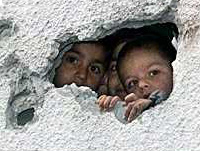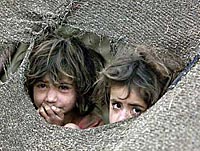|
Style,
substance and sympathy
Are
these nameless faces the Guernicas of our time?
by
Tarek Atia
cairolive.com,
February 28, 2002
 
The war of the icons, or the
eroding of the collective countenance of one's rivals, has long been
under way. Ink and photo are supplanting soldiery and tanks... It is
really an electric battle of information and of images that goes far
deeper and is more obsessional than the old hot wars of industrial
hardware... Electric persuasion by photo and movie and TV works by
dunking entire populations in new imagery."
Marshall McLuhan, Understanding Media
The two images above appear in
consecutive issues of prominent Egyptian newspaper Al-Ahram Weekly. The
photo on the left is of Palestinian refugees in Gaza looking out from a
bombed-out building. The photo on the right is of Afghani refugees
looking out from a raggedy makeshift tent.
Images of suffering children in a world full of misery and war
have become so commonplace that perhaps the most striking thing about
the two images above is just how similar they are in their creativity,
rather than any clear message they send about the situation the
children are in. So parallel is the style, that you'd think they were
taken by the same photographer.
The essence of both photos -- a
highly symbolic representation of innocent children trapped in horrible
circumstances -- is the same. But do these helpless, hidden people full
of woe inspire sympathy? Are they supposed to? Or has style -- the
elegant framing of the subjects, for one -- defeated any possibility of
engaging viewers in deep compassion with the subjects.
Randa Shaath, a photographer at the Weekly whose own images of
Palestinian suffering and resilience have been exhibited in Egypt,
Switzerland, and elsewhere, sees the images as "symbolic and
human".
Shaath says agency photographers -- having seen all manner of horror
in the world -- sometimes try to generalize the whole thing by going
symbolic. That can often immediately inspire sympathy with the
subjects -- but, she admits, it also lacks a point of view of the
larger conflicts involved.
Hani Shukrallah, the paper's managing editor, says the Weekly was
aware of the fact that similar photos were appearing in two subsequent
issues. "We thought it was interesting," he says. The Weekly
has always stressed the importance of strong photos -- editor-in-chief
Hosny Guindy reserves a significant amount of front page space for
photos -- preferably of the "humanistic" kind.
These days, with so much bad news to package for readers, Shukrallah
says his "preference is for something that individualizes
it."
"We don't like to show bodies that are torn to pieces. There's
something not respectful about it. Here there's a metaphor -- there's
a feeling of siege, a feeling of fear. There is something editorial
being felt -- the innocent eyes of children... Why can't they be
outside playing?"
That is a good question indeed. And if it is the question people ask
themselves when they see these photos, then perhaps every photo should
be like these two -- rather than the more gruesome variety of bodies
in ditches, for instance, in Afghanistan.
Despite the fact that a picture may say a thousand words, a short
answer to Shukrallah's question, "Why can't they be outside
playing?", does not really exist. And -- in this age of the quick
fix -- whether the photo has enough depth to at least provide some
realpolitic clue as why these particular children can't be outside
playing is questionable at best.
Shukrallah is of "two minds" when it comes to whether style
wins out over substance here. "Is it bad to have a beautiful
photo showing this? I don't know," he says. "Guernica is the
most famous statement horrifying war, but it's also beautiful."
Pablo Picasso painted "Guernica" in 1937 to express his
horror at the bombing of a Basque town during the Spanish Civil War.
On a wider scale, according to the The Cambridge Biographical
Encyclopedia, Guernica expresses a horror of war in general, as well
as Picasso's compassion and hope for its victims.
Are these nameless faces the Guernicas of our time?
If so, then consider what Shaath says about wire photographers being
confined by the political ideas of their agencies, and more directly,
of their editors, who choose from all of the images given to them.
"For an editor, it's often economics that drives the choices.
They want the picture to sell. Because it doesn't take sides, won't
offend anyone, a picture of a child in danger has a lot of commercial
potential."
If anything, Al-Ahram Weekly's running of the two wire-service images
in subsequent weeks opens our eyes to the symmetry of so much of the
misery going on in the world, and the numbness that is inevitable when
that symmetry is captured so regularly and artistically on film and in
print.
How these images play into media guru Marshall McLuhan's 1964 vision
-- quoted above -- of war via images is especially significant
considering how small a village the globe has become since then.
Both are wire service shots that perhaps reveal more about the psyche
of the media behemoths that produced them than they do about the
helplessness of the subjects themselves. Actually, their message
may be just that -- a ceaseless confirmation of the political and
economic prowess of whoever wields the camera.
Framed by the devastation that is their lives, its subjects are mere
pawns in a technological and ideological image game.
Which leads us to an important question: When you look at these
photographs, do you relate more to the photographer's vision, or to
the nameless subjects looking out from behind destruction at the
photographer's lens?
In other words, which side of the picture are you on?
photos
courtesy Al-Ahram Weekly, Issues # 572 & 573
Browse previous Dardasha columns here.
WHAT
DO YOU THINK?

MAKE YOUR
VOICE HEARD
Send a comment to cairolive.com

Disclaimer
and Terms of Use
© Copyright 1996-2005 cairolive.com. All Rights Reserved
|